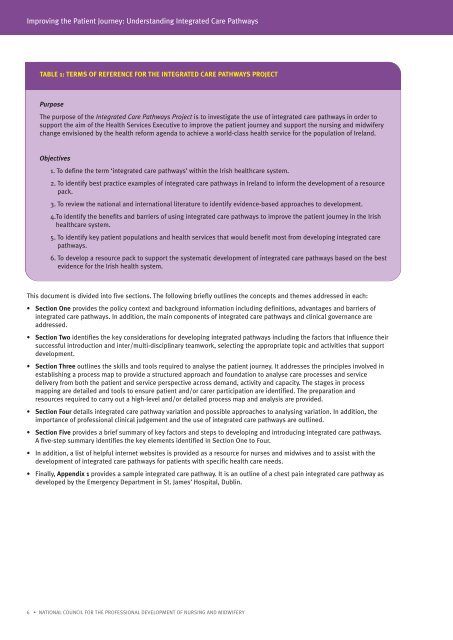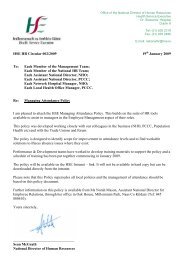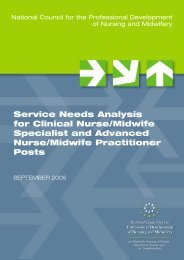Improving the Patient Journey: Understanding <strong>Integrated</strong> <strong>Care</strong> <strong>Pathways</strong>TABLE 1: TERMS OF REFERENCE FOR THE INTEGRATED CARE PATHWAYS PROJECTPurposeThe purpose of the <strong>Integrated</strong> <strong>Care</strong> <strong>Pathways</strong> Project is to investigate the use of integrated care pathways in order tosupport the aim of the Health Services Executive to improve the patient journey and support the nursing and midwiferychange envisioned by the health reform agenda to achieve a world-class health service for the population of Ireland.Objectives1. To define the term ‘integrated care pathways’ within the Irish healthcare system.2. To identify best practice examples of integrated care pathways in Ireland to inform the development of a resourcepack.3. To review the national and international literature to identify evidence-based approaches to development.4.To identify the benefits and barriers of using integrated care pathways to improve the patient journey in the Irishhealthcare system.5. To identify key patient populations and health services that would benefit most from developing integrated carepathways.6. To develop a resource pack to support the systematic development of integrated care pathways based on the bestevidence for the Irish health system.This document is divided into five sections. The following briefly outlines the concepts and themes addressed in each:• Section One provides the policy context and background information including definitions, advantages and barriers ofintegrated care pathways. In addition, the main components of integrated care pathways and clinical governance areaddressed.• Section Two identifies the key considerations for developing integrated pathways including the factors that influence theirsuccessful introduction and inter/multi-disciplinary teamwork, selecting the appropriate topic and activities that supportdevelopment.• Section Three outlines the skills and tools required to analyse the patient journey. It addresses the principles involved inestablishing a process map to provide a structured approach and foundation to analyse care processes and servicedelivery from both the patient and service perspective across demand, activity and capacity. The stages in processmapping are detailed and tools to ensure patient and/or carer participation are identified. The preparation andresources required to carry out a high-level and/or detailed process map and analysis are provided.• Section Four details integrated care pathway variation and possible approaches to analysing variation. In addition, theimportance of professional clinical judgement and the use of integrated care pathways are outlined.• Section Five provides a brief summary of key factors and steps to developing and introducing integrated care pathways.A five-step summary identifies the key elements identified in Section One to Four.• In addition, a list of helpful internet websites is provided as a resource for nurses and midwives and to assist with thedevelopment of integrated care pathways for patients with specific health care needs.• Finally, Appendix 1 provides a sample integrated care pathway. It is an outline of a chest pain integrated care pathway asdeveloped by the Emergency Department in St. James’ Hospital, Dublin.6 • NATIONAL COUNCIL FOR THE PROFESSIONAL DEVELOPMENT OF NURSING AND MIDWIFERY
SECTION 1<strong>Integrated</strong> <strong>Care</strong> <strong>Pathways</strong>POLICY CONTEXTOver past decades, multifaceted demographic, economic, political and social transformations have had a significant impact onthe patterns and dynamics of delivering healthcare in Ireland. Healthcare providers throughout the country have been undermounting pressure to balance increasing service demands within the resources available while ensuring patient safety andquality of care. The government and health services have developed policies, made structural and resource adjustments, andactively developed strategies to meet the challenges of a complex health system and provide a strategic direction and vision forthe future delivery of healthcare.The health strategy, Quality and Fairness: A Health System for You (Department of Health and Children 2001) established a visionfor the future and the principles to guide everyone working in the healthcare system. This strategy for the healthcare system hasfour national goals:• better health for everyone• fair access• responsive and appropriate care delivery• high performance.Since the Commission on Nursing in 1998, nursing and midwifery have been in a state of rapid change. Perhaps now, as neverbefore, the scope exists for nurses and midwives to develop their careers in response to service demands, professionalaspirations, policy drivers and, most importantly, patient need. The National Council for the Professional Development of Nursingand Midwifery was recommended by the Commission on Nursing and created by a Statutory Instrument from the Minister ofHealth and Children (SI Number 376 of 1999). The mission of the National Council is “to promote and develop the professionalrole of nurses and midwives in order to ensure the delivery of quality nursing and midwifery care to patients/clients in achanging healthcare environment”.The National Council for the Professional Development of Nursing and Midwifery firmly believes that integrated care pathwaydevelopment has enormous potential across every aspect of service delivery to contribute to driving and achieving the fournational goals of the health strategy. Some of the principles that underpin the concept of integrated care pathway development,and thereby support the four national goals of better health for everyone, fair access, responsive and appropriate care delivery,and high performance across a number of dimensions, include:• Patient-centerdness – integrated care pathways focus on the individual patient, respecting the patient’s choices, culture,social context and specific needs.• Safety and Quality – integrated care pathways drive safety and quality by promoting evidence-based practice and factoring incontinuous quality improvement at every point of healthcare delivery.• Effectiveness – integrated care pathways match care to science, identify ineffective care and provide the most reliable and upto-dateevidence to sustain effective healthcare.• Timeliness – integrated care pathways continually reduce waiting times and delays for both patients and those who providehealthcare.• Efficiency – integrated care pathways reduce inefficiency and thereby reduce waste and the total cost of healthcare; forexample, waste of supplies, equipment, space, capital, ideas, and human resources.• Equity – integrated care pathways, because they are patient-focused, provide opportunities to address and close socioeconomicgaps in health status.BACKGROUNDThe original concept of the integrated care pathway can be traced back to World War II, where they were developed as a planningtool for the United States of America Navy (Interhospital and Agency Clinical Pathway Group 2002). Over time they evolved andwere incorporated into different settings, for example, they were adopted as a method, for guiding complex engineering andconstruction projects. This flowchart format was first applied to healthcare in the 1980s when clinical pathways were used asNATIONAL COUNCIL FOR THE PROFESSIONAL DEVELOPMENT OF NURSING AND MIDWIFERY • 7













